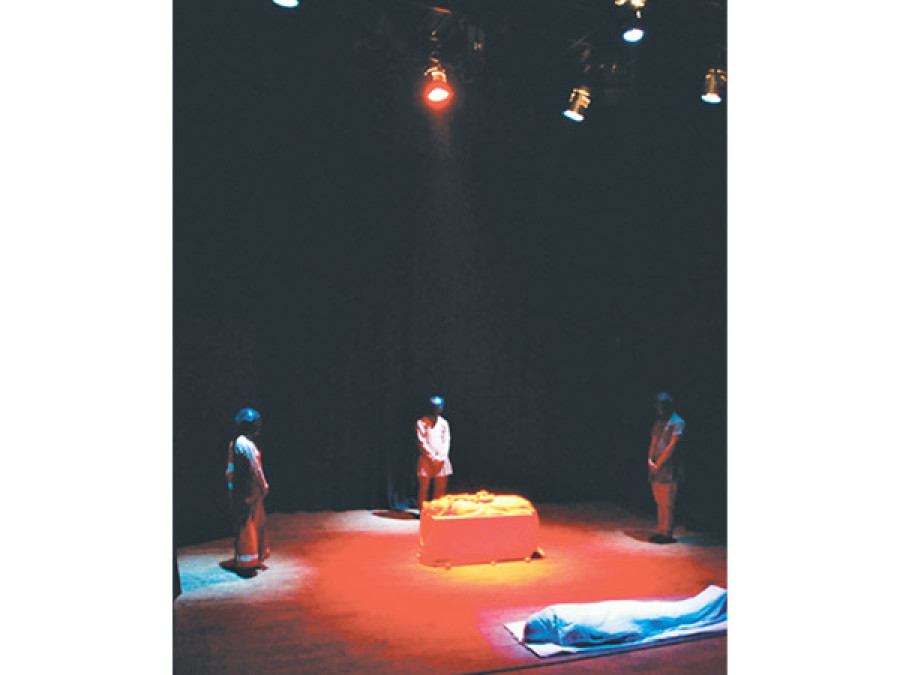Opinion
A theatre in transition
In 34 years, Sarwanam Theatre has pushed the boundaries of theatre and brought the art form closer to the masses.
Deepesh Paudel
Early years
As theatre pioneer, Sarwanam has lived a transitional life. In fact, its existence links two vastly different periods of Nepali theatre. Right after the physical retirement of literary and theatrical giants like Bal Krishna Sama and Bijaya Malla, Sarwanam came into the picture, promising radical expressions inclined towards the nation’s political scenario. Back then, more than theatrical technicality and processes, audiences were attracted and influenced by pertinent problems raised by the plays. The lack of freedom of speech, citizens’ inability to exercise their rights, and their pathos resulting from the autocratic regime were problems often incorporated in Sarwanam’s presentations. This allowed the masses to connect easily with the styles and subjects of Sarwanam’s theatrical endeavors.
In his article ‘Bikash Sancharma Sadak Natak, Sarwanam Ani Bertolt Brecht,’ Prof Abhi Subedi aptly calls Sarwanam a ‘theatre of salvation’, providing a voice to the voiceless. He also stresses how Sarwanam was able to deconstruct the established traditional arrangements of theatre presentations. For instance, street dramas initiated by Sarwanam created momentum among audiences who were deprived from other elitist theatre performances. In those for-the-mass plays, audiences were given the liberty to witness and take part in matters of their interest. Such plays reached out in a pervasive manner and not only spread much-needed awareness, but also instilled confidence among the audiences to make smaller changes in their lives.
Sadly, at times, these efforts initiated by Sarwanam were criticised by a few people. They made their case by stating that street dramas destroy the aesthetic beauty of theatre, and that theatre should remain within closed walls. Some of them even accused Sarwanam’s practice and claimed that the theatre was turning into an NGO, surviving on foreign funds. However, I believe that the theatre’s adherence towards street plays provided a new avenue for expression to society as a whole. Thereon, many social institutions and I/NGOs were able to utilise and benefit from this low-key art form.
Talking about the theatrics, Sarwanam went on to experiment with different methods of artistic expression, breaking traditional theatre styles. Avoiding curtain rolls, microphones (with a few exceptions), and other theatrical elements, the performances of Sarwanam set out to reach audiences in a most raw and natural form. During the 80s, theatre performances were driven mostly by melodramatic facial expressions, elongated dialogue speeches, and heavily-stacked stagecraft. Abandoning such conventional practices, Sarwanam brought a natural looking and controlled form of physical acting through its works. It also actively promoted frugal theatre, especially for aspiring artists who were constrained in terms of resources.
A new age
In contrast to the above matter, these days, Sarwanam’s same frugal approach is sometimes perceived as a weak link. This may be due to the increasing flow of funds in theatre and the audience’s growing interests towards extravagant features. However, irrespective of changing preferences and perceptions, Sarwanam’s unique approach towards theatre can be judged to be a powerful medium for pure expression.
Meanwhile, Sarwanam’s vision of incorporating aspiring youth in the field of theatre has been transcendental. Realising the rising need of newcomers and a younger generation, Sarwanam has been extensively breeding and encouraging young theatre artists to create fresh theatrical ventures. For instance, plays like Rato Sweater, Astitwa, Tri-Aayam, and Jimda Sapana, staged by Sarwanam’s theatre alumni, are the outcomes of the theatre’s mission to pass on the torch to the upcoming lot of artists. And, the best part about this process is that these plays have depicted their own originality in terms of concepts and presenting styles, entirely different from what Sarwanam holds.
Today, theatre’s styles and audience preferences have both seen massive changes. Technology and digital elements have significantly impacted the mechanism of theatre-making. People’s growing tendencies to take theatre as a substitute for movies and other entertainment media have laid challenges for theatre houses. Under such circumstances, for a theatre institution like Sarwanam, whose fundamentals are rooted in the past, it may be somewhat difficult to cater to the varying needs of today’s theatre-goers. But, for a theatre that has already lived through a transition, these evolving changes might not appear entirely uncertain and impossible.
Paudel is associated with Sarwanam Theatre as a theatre artist and director




 14.12°C Kathmandu
14.12°C Kathmandu











